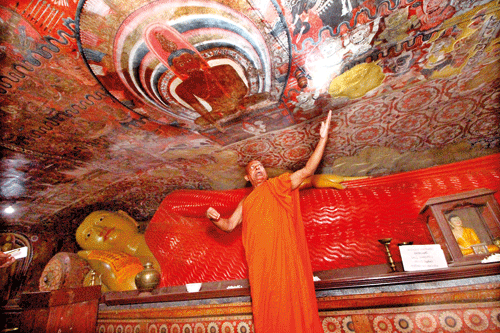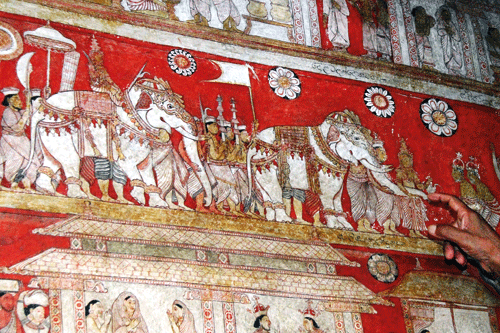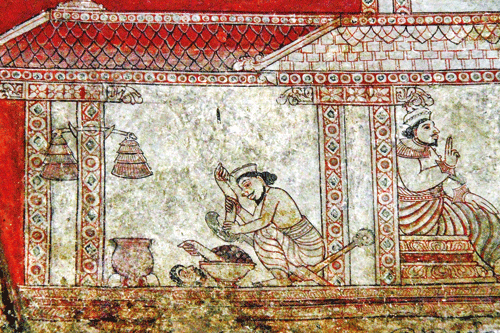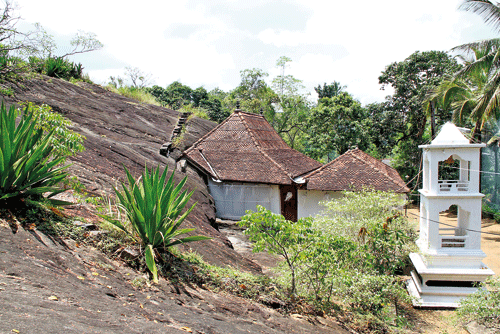Fast fading frescoes of Degaldoruwa

Signs of decay: Ven.Walapane Teripaha Piyaratne Thera points to the ceiling of the innermost chamber of the temple
The tale of Prince Wessantara, whose utmost generosity led him to give away all his possessions including his two children, is one of the most popular Jataka stories. It takes pride of place in many temple paintings and considered finest among these are the frescoes of the Degaldoruwa Raja Maha Viharaya in the village of Amunugama in Kandy.
Work on this rock temple had been initiated by King Kirthi Sri Rajasinghe (1747 – 1780), who was a great patron of Buddhist art. However he did not live to see the work completed but his younger brother King Rajadhi Rajasinghe who succeeded him saw to the completion of the work.
The Degaldoruwa frescoes caught the attention of none other than the great philosopher of art Ananda K. Coomaraswamy who called them the “best paintings I have yet seen in Ceylon”. Coomaraswamy also publicly canvassed for their preservation by way of an open letter to the Kandyan Chiefs published in the Ceylon Observer of February 17, 1905.
Coomaraswamy had spent 15 to 20 hours copying part of these frescoes as part of his work and in his letter to the Kandyan Chiefs who administered the temple funds, he made specific reference to the Degaldoruwa Vihara as one of the places in need of urgent repair.
The temple is built into a rock and one passes through three doors to reach the innermost chamber in which is an impressive statue of a reclining Buddha. On the ceiling of this rock chamber are also fine paintings of the life of the Buddha. Ven.Walapane Teripaha Piyaratne Thera, a resident monk at the Degaldoruwa Vihara who carries the three giant keys that open the doors of the different chambers explained in detail the various Jataka stories depicted in the paintings that tell the stories of the previous incarnations of Lord Buddha. “These paintings are invaluable not only to Buddhists but to people all over the world,” he said.
The frescoes of the Wessantara Jatakaya are on the left hand side of the inner door of the temple “pictured in the most worthiest and most beautiful manner imaginable,” as Coomaraswamy says quite aptly.

A regal procession: A scene from the Wessantara Jatakaya
The wall is divided horizontally into panels and the story of Prince Wessantara unfolds starting from the top. Coomaraswamy found the fresco of Prince Wessantara riding on his elephant with all the insignia of state as one of the grandest. “The elephant is drawn with the greatest skill, the slow movement of the lifted feet and the swinging bells give just the right idea of dignified slow progress; immediately afterwards the elephant is seen again but King Wessantara has climbed down and is walking in front, with one hand pouring water into the hands of the Brahmans from Kalinga, betokening the gift of the elephant, and with his other arm round the elephant’s trunk; the elephant has stopped the while, and the swinging bells are still.”
Coomaraswamy heaped much praise on this scene in the Jataka story. “The gorgeous trappings of the elephant, the king’s and the attendants dresses and the royal insignia are drawn with very great care and just like the early illuminated manuscripts of Europe are invaluable records of past manners and customs,” he wrote.
The story depicted on the right side of the inner door is the Sutasoma Jatakaya, the story of the King of Banaras who for a time was a cannibal but later converted by the preaching of Lord Buddha, in his then incarnation, became a virtuous man.
Coomaraswamy noted that the picture of the King’s cook preparing food in the royal kitchen is a valuable historical record. “The man is seated on a combined vegetable slicer and coconut scraper and is slicing up a

Portrayal of cannibalism: A scene from Sutasoma Jatakaya. Pix by Indika Handuwala
human arm for the king’s repast. On one of the posts of the kitchen is hung a pingo, (a carrying pole) with a ‘gahoniya’ (a bell shaped cloth used to cover food) hanging from each end, covering the chatties in which the king’s provisions had been brought that morning,” he noted.
The paintings are done in flat decorative style and the only colours used are red, black, yellow, white and greenish-grey, these colours made by the artists themselves.
The Temple stands today, a tribute to the great artisans of the yore, but worrying is the slow decay that has set in slowly erasing the fine paintings and posing the real threat that these maybe lost forever.
Ven. Watagamuwe Ananda Thera, a scholarly monk resident at the Raja Maha Viharaya voiced these concerns. “Of the six Jataka stories, only the Wessantara Jathaka and the Sutasoma Jataka panels remain well preserved while the other four are in various degrees of ruin. However of late, two of the Wessantara Jataka paintings too are slowly peeling away,” he said.
The temple is a protected site coming under the Archaeology Department, which through the Central Cultural Fund (CCF) engages in restoration work at the temple.
“Money has been allocated by the CCF to carry out restoration work on these frescoes but work is yet to get underway. “Work must be expedited as we can see that some of the paintings are beginning to fade and can be fully damaged without timely intervention,” Ananda Thera said.

Built into the rock: A side view of the Degaldoruwa Raja Maha Viharaya
Over 100 years ago, Ananda Coomaraswamy wrote, “Here are a series of paintings of great artistic and historical value; and if they are destroyed or injured by complete or even partial repainting, nothing can replace them.”
The challenge now is for the relevant authorities to act promptly to ensure that these invaluable frescoes are preserved for future generations.


